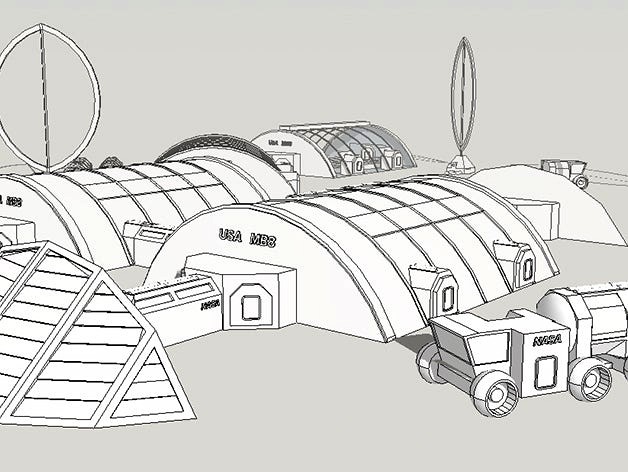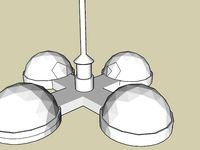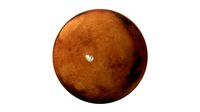Thingiverse

Mars Atmosphere Mine by NathansMind
by Thingiverse
Last crawled date: 2 years, 12 months ago
http://makergames.net/
Scientific Feasibility
I'?m under the impression that a successful manned mission to Mars will be measured by what can be sent back to earth. I think people will be very interested to see and touch objects from mars. I have designed a base that focuses on extracting and storing the necessary resources from the atmosphere for sustainable life and for propellant for return missions to earth.
I read a few articles about some possible executions for a mission to Mars, and I stumbled upon an article by Keli Rea that explains a possible process of in situ resource utilization (ISRU). The article dives into the chemistry of the Mars atmosphere and how it can be mined. In essence, by using an adsorption-based separator a team of astronauts could extract everything from oxygen (required for breathing and possibly an additive for fuel), nitrogen (required for agriculture) and propellant (required for moving around the planet and returning home).
My 3D design features a structure that would be used as an adsorption-based separator for the exploration team. It looks like and is compatible with the other buildings, but it has two large vents/filters that mine the atmosphere. The separator basically acts like a lung. As the pleasure in the Martian atmosphere changes during the day and night, it breathes in different gasses that can be processed inside. There are only basic principles of mechanics and little energy consumption involved in this process, which makes it ideal for planetary exploration.
The other structures in the colony satisfy the other basic needs of survival on Mars including living, gardening, and working. All the structures in the colony are based on a long-standing design farmers use as quick and affordable shelters for their crops and equipment. The beauty of these curved structures is that they are incredibly versatile and strong; in fact, they can be partially buried to provide more strength and security. I have enhanced them with modular components so that they can be easily assembled and organized depending on the Martian surface.
In addition to the living arrangements, I also created a vehicle that will be crucial in meeting the everyday demands of live on the Red planet. Water in particular will be tricky to extract from the harsh environment. It will require some heavy equipment to extract it from the frozen landscape. I originally imagined the vehicle being powered by methane, but I read that Curiosity did not detect Methane in the atmosphere, so I'll probably propose an electric motor of some kind. There could be some potential in using carbon monoxide (mined from the atmosphere) fuel cells as a source of power. While the vehicle has to do some heavy lifting, the task is made easier by the fact that mars has one third the gravitational pull of earth, so I'm sure a beefy electric motor could get a lot done.
As far a powering the rest of the colony, my design relies heavily on wind power. I designed a few vertical axis wind turbines that would harvest Martian winds. I don't object to solar power, in fact it has a place in my design, but I don't feel relying on it entirely is a good idea. A month long dust storm on Mars could drain life support systems to exhaustion if solar power was the only option. There is a great article on using wind power in my sources.
Ultimately, the goal of an initial mission to mars would be to establish a base that is functional and self-sustaining. While I may not have worked out all of the details of a Martian voyage, I believe that atmospheric mining, solid modular structures, and multifaceted power supplies could all be part of a real mission to mars. I could probably go on for another 5 paragraphs about how I think this base could be transported to Mars, but I will save that for another challenge.
Sources:
Adsorption-based separator:
http://en.wikipedia.org/wiki/Pressure_swing_adsorption
Mars in situ resource utilization (ISRU):
http://www.academia.edu/1536919/Processes_for_a_Mars_Base_CO2_Refinery_Mining_the_Atmosphere
NASA's Curiosity detects no methane on Mars, ruling out life on Mars:
http://www.extremetech.com/extreme/167067-nasas-curiosity-detects-no-methane-on-mars-ruling-out-life-on-mars
Carbon Monoxide Fuel Cells:
http://phys.org/news965.html
Polar Wind Turbines Could Be Used On Mars:
http://www.marsdaily.com/reports/Polar_Wind_Turbines_Could_Be_Used_On_Mars.html
Printability
I actually don't have access to a 3D printer, so from the reading I've done and from the designs I've seen on this site, I've done my best to make this design as printable as possible. I downloaded the Makerware printing software, and everything seems to load great. I used the default settings, so they may need some tweaking to get it to print right. I'm a little concerned about scale when printing them all together. It may be better to print them separately, or al least in smaller batches.
I have broken out a lot of the components into separate printable parts that can be assembles, and I've tried to avoid overhangs. I would appreciate any feedback on the printability of these designs.
Creativity
Regardless of how creative this design is judged to be, it has been a lot of fun researching and thinking through the challenges that are waiting on our sister planet. I have also really enjoyed seeing the solutions other people have come up with. Let me know if you have any feedback.
Scientific Feasibility
I'?m under the impression that a successful manned mission to Mars will be measured by what can be sent back to earth. I think people will be very interested to see and touch objects from mars. I have designed a base that focuses on extracting and storing the necessary resources from the atmosphere for sustainable life and for propellant for return missions to earth.
I read a few articles about some possible executions for a mission to Mars, and I stumbled upon an article by Keli Rea that explains a possible process of in situ resource utilization (ISRU). The article dives into the chemistry of the Mars atmosphere and how it can be mined. In essence, by using an adsorption-based separator a team of astronauts could extract everything from oxygen (required for breathing and possibly an additive for fuel), nitrogen (required for agriculture) and propellant (required for moving around the planet and returning home).
My 3D design features a structure that would be used as an adsorption-based separator for the exploration team. It looks like and is compatible with the other buildings, but it has two large vents/filters that mine the atmosphere. The separator basically acts like a lung. As the pleasure in the Martian atmosphere changes during the day and night, it breathes in different gasses that can be processed inside. There are only basic principles of mechanics and little energy consumption involved in this process, which makes it ideal for planetary exploration.
The other structures in the colony satisfy the other basic needs of survival on Mars including living, gardening, and working. All the structures in the colony are based on a long-standing design farmers use as quick and affordable shelters for their crops and equipment. The beauty of these curved structures is that they are incredibly versatile and strong; in fact, they can be partially buried to provide more strength and security. I have enhanced them with modular components so that they can be easily assembled and organized depending on the Martian surface.
In addition to the living arrangements, I also created a vehicle that will be crucial in meeting the everyday demands of live on the Red planet. Water in particular will be tricky to extract from the harsh environment. It will require some heavy equipment to extract it from the frozen landscape. I originally imagined the vehicle being powered by methane, but I read that Curiosity did not detect Methane in the atmosphere, so I'll probably propose an electric motor of some kind. There could be some potential in using carbon monoxide (mined from the atmosphere) fuel cells as a source of power. While the vehicle has to do some heavy lifting, the task is made easier by the fact that mars has one third the gravitational pull of earth, so I'm sure a beefy electric motor could get a lot done.
As far a powering the rest of the colony, my design relies heavily on wind power. I designed a few vertical axis wind turbines that would harvest Martian winds. I don't object to solar power, in fact it has a place in my design, but I don't feel relying on it entirely is a good idea. A month long dust storm on Mars could drain life support systems to exhaustion if solar power was the only option. There is a great article on using wind power in my sources.
Ultimately, the goal of an initial mission to mars would be to establish a base that is functional and self-sustaining. While I may not have worked out all of the details of a Martian voyage, I believe that atmospheric mining, solid modular structures, and multifaceted power supplies could all be part of a real mission to mars. I could probably go on for another 5 paragraphs about how I think this base could be transported to Mars, but I will save that for another challenge.
Sources:
Adsorption-based separator:
http://en.wikipedia.org/wiki/Pressure_swing_adsorption
Mars in situ resource utilization (ISRU):
http://www.academia.edu/1536919/Processes_for_a_Mars_Base_CO2_Refinery_Mining_the_Atmosphere
NASA's Curiosity detects no methane on Mars, ruling out life on Mars:
http://www.extremetech.com/extreme/167067-nasas-curiosity-detects-no-methane-on-mars-ruling-out-life-on-mars
Carbon Monoxide Fuel Cells:
http://phys.org/news965.html
Polar Wind Turbines Could Be Used On Mars:
http://www.marsdaily.com/reports/Polar_Wind_Turbines_Could_Be_Used_On_Mars.html
Printability
I actually don't have access to a 3D printer, so from the reading I've done and from the designs I've seen on this site, I've done my best to make this design as printable as possible. I downloaded the Makerware printing software, and everything seems to load great. I used the default settings, so they may need some tweaking to get it to print right. I'm a little concerned about scale when printing them all together. It may be better to print them separately, or al least in smaller batches.
I have broken out a lot of the components into separate printable parts that can be assembles, and I've tried to avoid overhangs. I would appreciate any feedback on the printability of these designs.
Creativity
Regardless of how creative this design is judged to be, it has been a lot of fun researching and thinking through the challenges that are waiting on our sister planet. I have also really enjoyed seeing the solutions other people have come up with. Let me know if you have any feedback.
Similar models
grabcad
free

Mars ISRU atmospheric processing module
...- 2 freezing chambers to freeze co2
- 4 compressors to move the gas and provide redundancy,
- 1 cryo-cooler,
- 4 storage tanks
thingiverse
free

Mars Base Two by Spurcell
...rse
a wind powered base featuring a squat hexagonal tower design. designed to resist and take advantage of strong martian winds.
thingiverse
free

Ares permanent settlement by zivziv
...n rover.
in the event of a solar flare the crew will take shelter in an underground bunker until it is safe to leave the shelter.
cg_trader
$5

Scifi Mars Habitat
...f propellant. without isru the cost of importing materials from earth renders the project of extraterrestrial futures impossible.
free3d
free

Curiosity Rover
...curiosity rover
free3d
here is another model i made from nasa pictures that i could find. the mars curiosity rover. enjoy.
cg_trader
$99

Viking Lander
...re and soil, and to search for evidence of life on mars. download today, and relive the golden age of nasa and the space program!
thingiverse
free

MER/Curiosity Marsdial Camera Calibration Target by JamesSorenson
... result is close, there are likely some dimensions that are off a little bit from the original flight model that went to mars. :)
cg_trader
$59

Atlas V 541 Mars Curiosity Rover Mission
...atlas v 541 mars curiosity rover mission
cg trader
hi i am frezzy from vnvisual studio.
grabcad
free

Mars Glider Project
...mars glider project
grabcad
wing design for flight in the martian atmosphere
3dwarehouse
free

Martian Rover
...martian rover
3dwarehouse
a rover designed for a man mission to mars. #mars #mars_rover #rover
Nathansmind
thingiverse
free

Simple Tank by NathansMind
...simple tank by nathansmind
thingiverse
a quick concept.
thingiverse
free

Barrel by NathansMind
...el by nathansmind
thingiverse
this is a barrel. it's about 2cm high. a decent size for 28mm wargaming.http://makergames.net/
thingiverse
free

Road signs by NathansMind
...road signs by nathansmind
thingiverse
some more pieces for 28mm wargaming.http://makergames.net/
thingiverse
free

Mini Monster Pawn by NathansMind
...i monster pawn by nathansmind
thingiverse
game piece for a game i am developing. some scaling is required.http://makergames.net/
thingiverse
free

Half Round Work Shed by NathansMind
...half round work shed by nathansmind
thingiverse
an experimental design for wargaming.
more designs: http://makergames.net/
thingiverse
free

Battle Dice by NathansMind
...pe i am putting together. two faces have shields, two faces have crosshairs, and the other faces are blank.http://makergames.net/
thingiverse
free

Battered Oil Barrels by NathansMind
... wargaming. might need to be scaled a bit.http://makergames.net/
join our group: http://www.thingiverse.com/groups/maker-games/
thingiverse
free

Worn Out Tractor Tire by NathansMind
...e
i'll be turning this and a couple other pieces into a diorama.
checkout more of my designs at http://www.makergames.net
thingiverse
free

Stack of Truck Tires by NathansMind
... i these would be cool by themselves for spicing up a tabletop game.
check out more of my designs at http://www.makergames.net
thingiverse
free

Dragon's Teeth Tank Traps by NathansMind
...erse
i thought these would be pretty cool on the table top. they are scaled roughly for 28mm wargames.
http://makergames.net/
Atmosphere
3ddd
free

Vintage - atmosphere
...vintage - atmosphere
3ddd
atmosphere
люстра atmosphere l54
155x165 cm
3ddd
$1

Кресло Asnaghi Atmosphere
...сло asnaghi atmosphere
3ddd
asnaghi , atmosphere
кресло asnaghi atmosphere в900г920ш860
turbosquid
$1

planets + atmosphere
... available on turbo squid, the world's leading provider of digital 3d models for visualization, films, television, and games.
3d_ocean
$12

Earth with Atmosphere
...tars system universal way world
this is the earth with atmosphere. the textures file including the 6 maps. thank you for looking.
cg_studio
$10

Atmospheric Processor3d model
...atmospheric processor3d model cgstudio weyland-yutani processor atmosphere processing plant weyland corp (lv-426) aliens .obj .mb .fbx...
3d_export
$32

Atmospheric Processor 3D Model
...laliensspaceripleycameronmarinesdropshiparchitecturalexteriorscififantasy
atmospheric processor 3d model sanchiesp 93517 3dexport
3ddd
$1

Торшер Soiree 2013 Dizzy Atmosphere
...
3ddd
soiree , dizzy atmosphere
торшер soiree 2013 dizzy atmosphere из муранского стекла
3d_export
$6

Design of Atmospheric Mist Water Generator
...design of atmospheric mist water generator
3dexport
design of atmospheric mist water generator
3ddd
free

BAMAX - New atmospheres 2008 - 63.831
...pheres 2008 - 63.831
3ddd
bamax , консоль
консоль bamax - new atmospheres 2008 - 63.831
turbosquid
$10

Chinese atmosphere installations umbrella
...mosphere installations umbrella for download as fbx and blend on turbosquid: 3d models for games, architecture, videos. (1481622)
Mars
3d_ocean
$10

Mars
...tar stars system universal way world
this is the mars with atmosphere. the textures file including 4 maps. thank you for looking.
turbosquid
$2

MARS
...
turbosquid
royalty free 3d model mars for download as blend on turbosquid: 3d models for games, architecture, videos. (1170651)
3ddd
free

ClassiCon Mars
...classicon mars
3ddd
classicon , mars
стул mars от classicon.
3ds max 2011 + fbx. vray.
turbosquid
$12

Mars
...id
royalty free 3d model mars for download as blend and gltf on turbosquid: 3d models for games, architecture, videos. (1659040)
turbosquid
$1

the mars
...oyalty free 3d model the mars for download as blend and blend on turbosquid: 3d models for games, architecture, videos. (1704346)
turbosquid
free

mars
...squid
royalty free 3d model mars for download as max and obj on turbosquid: 3d models for games, architecture, videos. (1355198)
turbosquid
$59

Mars
...
royalty free 3d model mars for download as max, obj, and fbx on turbosquid: 3d models for games, architecture, videos. (1259238)
turbosquid
$12

Mars
...lty free 3d model mars for download as 3ds, max, obj, and fbx on turbosquid: 3d models for games, architecture, videos. (1152228)
turbosquid
$5

Mars
...y free 3d model mars for download as obj, fbx, blend, and dae on turbosquid: 3d models for games, architecture, videos. (1292956)
3d_export
free

mars landscape
...mars landscape
3dexport
mars landscape made with word machine.
